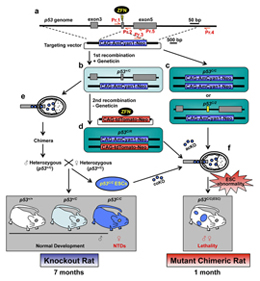Research Abstract
2つの異なるノックアウトアプローチによりラットの発生におけるp53の重要な役割が浮き彫りになる
Two distinct knockout approaches highlight a critical role for p53 in rat development
2012年12月10日 Scientific Reports 2 : 945 doi: 10.1038/srep00945

胚性幹細胞(ESC)における遺伝子ターゲッティングは、ノックアウトモデル作製の主要な技術となっている。p53の破壊が発生異常や悪性腫瘍の増加を引き起こすと予測する研究が多数あるが、p53ノックアウトマウスの大部分は正常に発生する。そのため、ラットのノックアウトモデルを用いて、動物の発生におけるp53の役割を検討した。常法で作製したホモ接合性KOの雄ラットは正常に発生したが、雌ラットは神経管閉鎖障害のため、まれにしか生存しなかった。p53ヌルESCの胚盤胞注入により作製した変異キメララットは、両性共に高い胚性致死率を示した。この表現型は、ジンクフィンガーヌクレアーゼを用いることで、1か月で観察可能だった。p53ヌルESCは、アポトーシスや分化に抵抗性で、また、キメラが寄与する細胞では重度の染色体不安定性を示したことから、ESCの質とゲノムの完全性の維持にp53が重要な役割を担っていることが示唆される。これらの結果は、p53がラットにおける胚発生の保護因子として機能することを実証している。
川又 理樹1 & 落谷 孝広1
- 独立行政法人 国立がん研究センター研究所 分子細胞治療研究分野
Gene targeting in embryonic stem cells (ESCs) has become the principal technology for generating knockout models. Although numerous studies have predicted that the disruption of p53 leads to increased developmental anomalies and malignancies, most p53 knockout mice develop normally. Therefore, the role of p53 in animal development was examined using rat knockout models. Conventionally generated homozygous KO males developed normally, whereas females rarely survived due to neural tube defects. Mutant chimeras generated via blastocyst injection with p53-null ESCs exhibited high rates of embryonic lethality in both sexes. This phenotype could be observed in one month by the use of zinc-finger nucleases. The p53-null ESCs were resistant to apoptosis and differentiation, and exhibited severe chromosome instabilities in the chimera-contributed cells, suggesting an essential role for p53 in maintaining ESC quality and genomic integrity. These results demonstrate that p53 functions as a guardian of embryogenesis in the rats.

